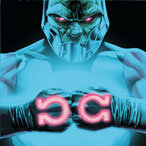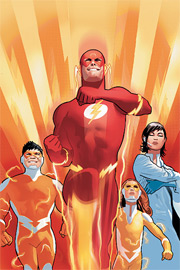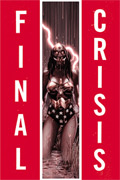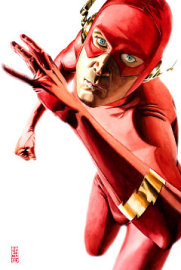 Three issues into Final Crisis, there’s a large contingent of people who feel that the book is “impenetrable,” and that it requires an encyclopedic knowledge of the DC Universe in order to understand it. I disagree. In fact, I think up to a point, knowledge of DC actually makes it harder to understand it.
Three issues into Final Crisis, there’s a large contingent of people who feel that the book is “impenetrable,” and that it requires an encyclopedic knowledge of the DC Universe in order to understand it. I disagree. In fact, I think up to a point, knowledge of DC actually makes it harder to understand it.
From what I’ve read, the biggest complaints seem to be coming from people who know quite a bit about the DC universe and are annoyed that they don’t know the background on, say, Frankenstein (as he fits into the DCU), or Anthro, or Libra, etc. On the other hand, people who aren’t totally immersed in DC history assume they’re not going to recognize everyone, and are more willing to go with the flow.
Certainly, the book is steeped in the DC Universe. But for the most part, the characters’ back-stories don’t seem to be necessary to understand what’s going on in this story.
Example 1: The prologue in the first issue was set in pre-history, in which Metron of the New Gods filled the Prometheus role and gave fire to humans. A cavemen battle featured DC characters Anthro and Vandal Savage. A lot of people complained that if they hadn’t recognized the characters, they’d be lost. Well, no, not really — they’d just see a battle among cavemen, which gets the main idea across quite nicely.
Example 2: Frankenstein and S.H.A.D.E. figure prominently in the opening scenes of issue three. If you haven’t read Seven Soldiers: Frankenstein, you might wonder what the heck Frankenstein’s monster is doing working for an F.B.I.-like agency. On the other hand, the scene would still work if it were a random F.B.I. or S.H.A.D.E. agent. The back-story on the character isn’t necessary to understand his role here.
Oddly, I haven’t seen anyone complaining (yet) that they needed to pick up a Cave Carson showcase in order to understand the scene in which they discover a petroglyph.
 I believe it was Bruce Timm who explained that on the Justice League cartoon, they made an effort to use existing characters from DC’s stable whenever possible. In one episode they needed a sniper. They could have just had a random sniper, but they looked through DC’s roster and decided to use Deadshot. Was Deadshot’s background necessary to understand the resulting episode? Not at all.
I believe it was Bruce Timm who explained that on the Justice League cartoon, they made an effort to use existing characters from DC’s stable whenever possible. In one episode they needed a sniper. They could have just had a random sniper, but they looked through DC’s roster and decided to use Deadshot. Was Deadshot’s background necessary to understand the resulting episode? Not at all.
In a lot of these cases, what readers are missing isn’t a critical piece of the story — it’s bonus material. And again, it’s the people who have a solid but not thorough knowledge of DC who feel left out, because they know, say, JLA backward and forward, but not Kamandi, or they’ve memorized everything Geoff Johns has ever written, but didn’t read Seven Soldiers. So they feel like they should know the back-story.
As an experiment, I handed the first issue to my wife, whose familiarity with the DC Universe mainly comes from the animated Justice League. She had some questions, certainly, but she was able to understand most of what was going on.
Working up the scale, you eventually get to the readers who do recognize almost everything, and then the key issue becomes: what attitude do they take toward the parts they don’t know? Are they frustrating? Or are they puzzles to solve?
As for myself, admittedly I do have a strong grounding in the DCU, having read a lot of their comics over the past two decades. But there were still characters I didn’t recognize, like Dan Turpin and Sonny Sumo. Heck, I missed the fact that the evil caveman in the prologue was Vandal Savage, which enhances a later scene (when Libra mentions that the world has been waiting a long time for Vandal Savage to make good on his threats to conquer it*). Even so, these gaps in my DC knowledge didn’t prevent me from figuring out what was going on, because I thought, oh, these must be new characters. Picking up the details through sites like Final Crisis Annotations certainly enhanced the experience, but I didn’t feel that my initial reading had suffered at all.
So in short, here’s my theory (well, really it’s just a hypothesis) on how readers react to Final Crisis:
- Minimal DC knowledge: Accepts gaps in knowledge, goes with what they do know and what’s on the page, and follows the book.
- Medium DC knowledge: Gaps in knowledge are infuriating, feels the book is impenetrable.
- Extensive DC knowledge: Follows the book, then gets involved in discussions afterward to see what they missed.
*I prefer the take given by some story I can’t remember, in which Vandal Savage says, “From time to time, I have chosen to rule the world.” It makes him more menacing, to think that for the most part he isn’t really trying, and when he has put the effort in, he’s succeeded.

 Final Crisis #3 was released today, and the Anti-Life Equation hit the Internet.
Final Crisis #3 was released today, and the Anti-Life Equation hit the Internet.

